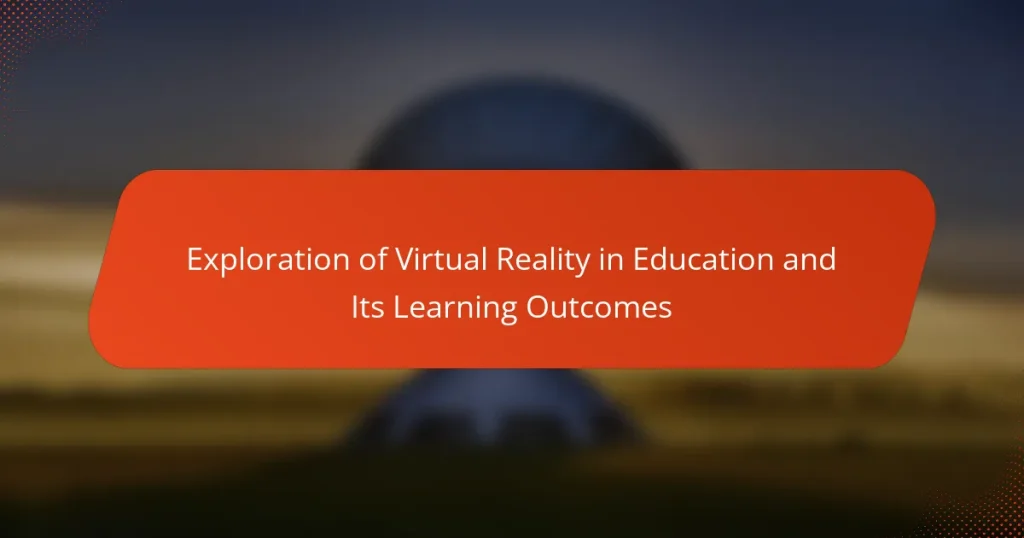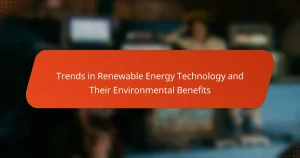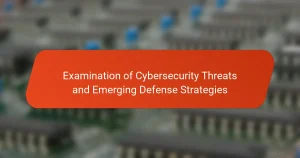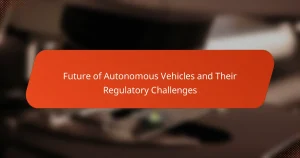Virtual Reality (VR) in education is an innovative technology that creates immersive simulated environments for learners, enhancing engagement and understanding of complex subjects. This technology enables students to interact with three-dimensional models and scenarios, significantly improving retention rates and learning outcomes. Research indicates that VR not only fosters collaboration and critical thinking skills but also allows for experiential learning in safe settings. Studies show that VR users often achieve higher test scores and retention compared to traditional learning methods. As VR technology advances and becomes more accessible, it is poised to transform educational practices and experiences significantly.
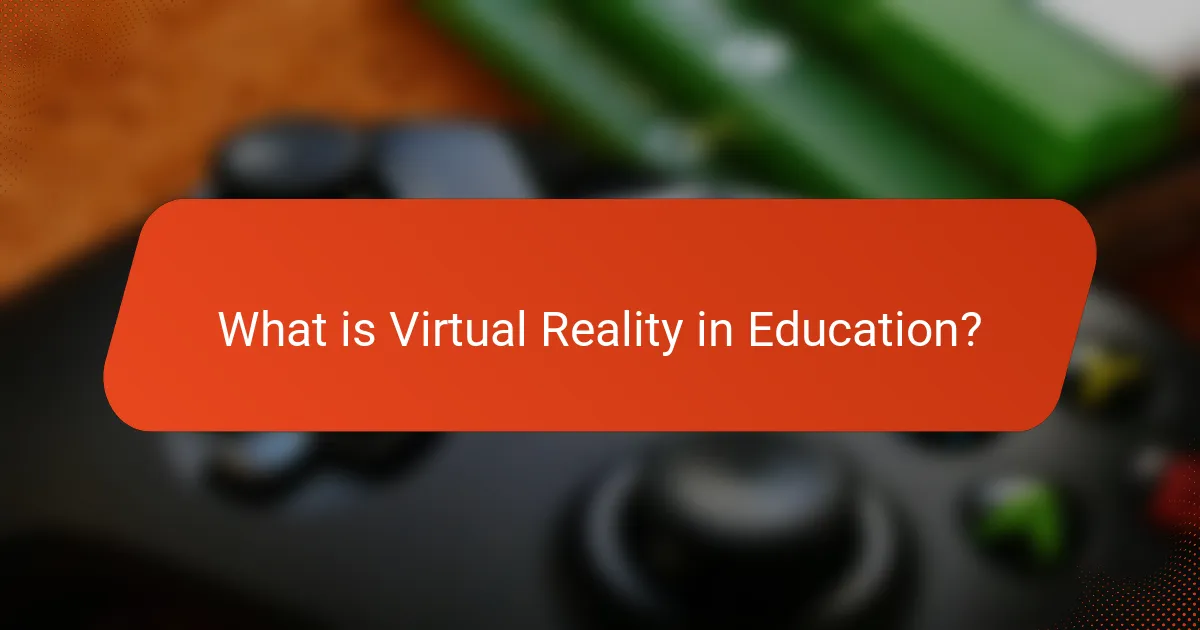
What is Virtual Reality in Education?
Virtual Reality in education is an immersive technology that creates a simulated environment for learners. It allows students to interact with 3D models and scenarios, enhancing engagement and understanding. This technology can simulate real-world experiences, making complex subjects more accessible. For instance, medical students can practice surgeries in a virtual setting. Research shows that VR can improve retention rates and learning outcomes. A study by Mikropoulos and Natsis (2011) found that VR enhances spatial abilities and understanding in science education. Overall, Virtual Reality is transforming educational methods and experiences.
How is Virtual Reality defined within the educational context?
Virtual Reality (VR) in the educational context is defined as an immersive technology that simulates real-world environments. It enables interactive learning experiences through 3D visualizations and sensory engagement. VR enhances student engagement by providing experiential learning opportunities. Studies show that VR can improve retention rates and understanding of complex subjects. For instance, a study by Mikropoulos and Natsis (2011) found that VR significantly increased students’ motivation and learning outcomes in science education. This technology allows for safe exploration of scenarios that may be difficult or impossible to replicate in a traditional classroom setting.
What are the key features of Virtual Reality technology?
Key features of Virtual Reality technology include immersive environments, interactive simulations, and sensory engagement. Immersive environments allow users to experience a computer-generated world as if they are physically present. Interactive simulations enable real-time user interaction with the virtual environment, enhancing engagement. Sensory engagement involves the use of visual, auditory, and haptic feedback to create a realistic experience. These features are crucial for applications in education, as they promote active learning and retention. Studies have shown that immersive learning experiences can improve understanding and retention of complex subjects.
How does Virtual Reality differ from traditional educational methods?
Virtual Reality (VR) offers immersive experiences that traditional educational methods cannot provide. VR allows learners to engage in simulated environments, enhancing interaction and participation. Traditional methods often rely on passive learning through lectures and textbooks. In contrast, VR encourages active learning through exploration and hands-on activities. Studies show that VR can improve retention rates by up to 75% compared to conventional methods. This is because VR caters to various learning styles, including visual and kinesthetic. Additionally, VR can create scenarios that are difficult or impossible to replicate in a classroom setting. For instance, medical students can practice surgeries in a risk-free virtual environment.
Why is Virtual Reality becoming popular in education?
Virtual Reality is becoming popular in education due to its immersive learning experiences. It engages students in ways traditional methods cannot. VR allows for interactive simulations that enhance understanding of complex subjects. For example, medical students can practice surgeries in a safe environment. Research shows that VR can improve information retention by up to 75%. Additionally, it caters to diverse learning styles, making education more accessible. Schools and universities are increasingly adopting VR to prepare students for real-world applications. This trend reflects a growing recognition of technology’s role in modern education.
What are the driving factors behind the adoption of Virtual Reality in classrooms?
The driving factors behind the adoption of Virtual Reality in classrooms include enhanced engagement, improved learning outcomes, and accessibility of complex concepts. Virtual Reality creates immersive experiences that capture students’ attention. Research shows that students are more likely to retain information when they are actively involved in learning. Additionally, VR allows for experiential learning, where students can practice skills in a safe environment. This technology also caters to diverse learning styles, accommodating visual and kinesthetic learners. Furthermore, VR can simulate real-world scenarios that are otherwise difficult to replicate in traditional settings. As of 2021, studies indicate that schools using VR report increased motivation and participation among students. These factors contribute to the growing integration of Virtual Reality in educational environments.
How does Virtual Reality enhance student engagement and motivation?
Virtual Reality enhances student engagement and motivation by providing immersive learning experiences. These experiences allow students to interact with educational content in a dynamic way. For instance, studies show that VR can increase retention rates by up to 75%. Students are more likely to participate actively in lessons when using VR technology. This technology creates realistic environments that stimulate curiosity and exploration. According to a study published in the Journal of Educational Technology, VR significantly improves student focus. The interactive nature of VR encourages collaboration among peers, boosting motivation. Overall, the engaging format of VR leads to a deeper understanding of complex subjects.
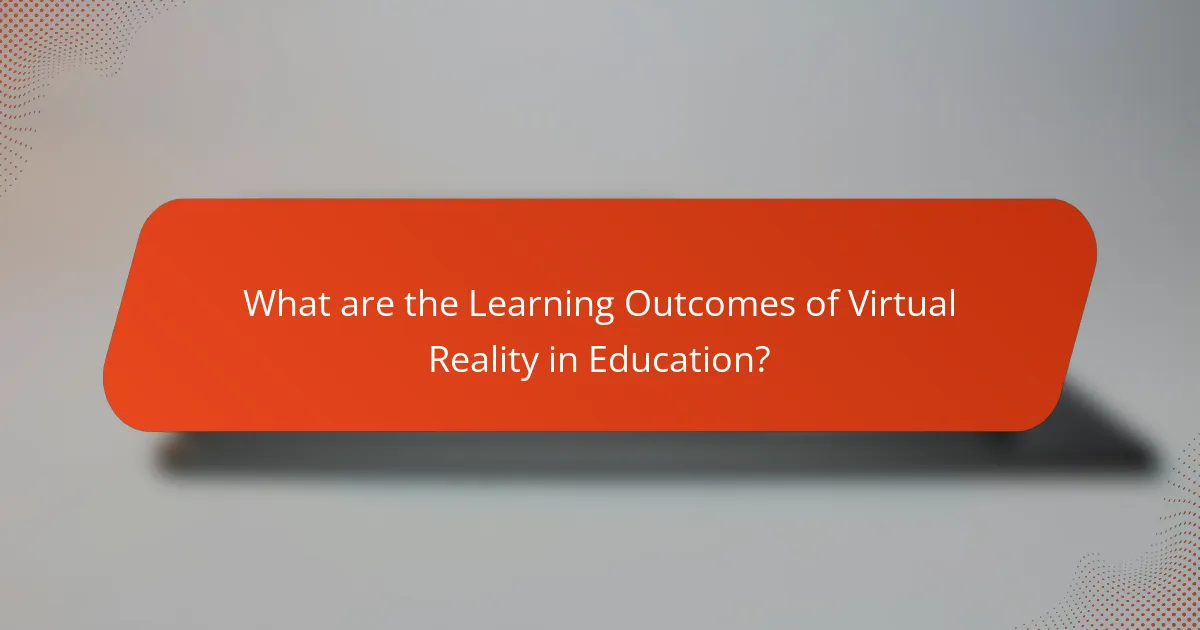
What are the Learning Outcomes of Virtual Reality in Education?
Learning outcomes of virtual reality in education include enhanced engagement, improved retention of information, and the development of critical thinking skills. Virtual reality immerses students in interactive environments. This immersion promotes active learning and participation. Studies show that students retain information better when they experience it in a virtual setting. For example, a study published in the journal “Computers & Education” found a 76% increase in retention rates among students using VR for learning. Additionally, virtual reality fosters collaboration among students, encouraging teamwork and communication skills. It also allows for experiential learning, where students can practice skills in safe, controlled environments. Overall, virtual reality in education leads to deeper understanding and application of knowledge.
How does Virtual Reality impact student learning outcomes?
Virtual Reality (VR) enhances student learning outcomes by providing immersive and interactive experiences. These experiences engage students more deeply than traditional methods. Research indicates that VR can improve retention rates by up to 75%. The immersive nature of VR allows learners to visualize complex concepts in a tangible way. Students can practice skills in a safe, controlled environment. This experiential learning leads to better understanding and application of knowledge. VR also caters to diverse learning styles, accommodating visual, auditory, and kinesthetic learners. According to a study by Mikropoulos and Natsis (2011), VR significantly boosts motivation and engagement in educational settings.
What evidence supports the effectiveness of Virtual Reality in improving knowledge retention?
Virtual Reality (VR) has been shown to improve knowledge retention effectively. A study conducted by Mikropoulos and Natsis (2011) found that students using VR environments scored significantly higher on knowledge retention tests compared to those in traditional learning settings. Another research by Merchant et al. (2014) demonstrated that immersive VR experiences led to better recall of information in students. Furthermore, a meta-analysis by Cheng et al. (2020) confirmed that VR enhances learning outcomes, particularly in retention and engagement. These findings collectively support the effectiveness of VR in enhancing knowledge retention in educational contexts.
How does Virtual Reality facilitate skill development in students?
Virtual Reality (VR) facilitates skill development in students by providing immersive, interactive learning experiences. VR allows students to practice skills in simulated environments that mimic real-world scenarios. This hands-on approach enhances engagement and retention of information. For instance, medical students can perform virtual surgeries, improving their practical skills without risk to patients. Research shows that VR training can lead to better performance in real-life tasks. A study published in the Journal of Educational Technology & Society found that students using VR scored 30% higher in skill assessments compared to traditional methods. This evidence demonstrates VR’s effectiveness in skill acquisition and application.
What challenges are associated with implementing Virtual Reality in education?
Implementing Virtual Reality in education faces several challenges. High costs are a significant barrier, as VR hardware and software can be expensive. Limited access to technology in some schools further complicates implementation. Additionally, there is a lack of trained educators who can effectively integrate VR into their teaching. Content development for VR can be time-consuming and requires specialized skills. Furthermore, not all students may respond positively to VR learning experiences. Some may experience motion sickness or discomfort while using VR. Lastly, measuring the effectiveness of VR in achieving educational outcomes remains a challenge. Studies indicate that without proper assessment methods, the impact of VR on learning can be difficult to quantify.
What are the common barriers to adopting Virtual Reality in educational institutions?
The common barriers to adopting Virtual Reality in educational institutions include high costs, lack of infrastructure, and insufficient training for educators. High costs involve the price of VR hardware and software, which can be prohibitive for many schools. Lack of infrastructure refers to inadequate technology support and internet connectivity in some educational settings. Insufficient training for educators means that teachers may not be equipped to effectively integrate VR into their curricula. A study by the International Society for Technology in Education (ISTE) highlights these challenges, indicating that budget constraints and training gaps hinder VR adoption in schools.
How can educators overcome these challenges to maximize learning outcomes?
Educators can overcome challenges in virtual reality (VR) education by implementing structured training and resources. Training programs enhance educators’ familiarity with VR technology. This leads to more effective integration into the curriculum. Additionally, collaboration with technology experts can provide ongoing support. Access to quality VR content is crucial for maximizing learning outcomes. Research shows that well-designed VR experiences can increase engagement and retention. A study by Mikropoulos and Natsis (2011) found that students using VR demonstrated improved understanding of complex subjects. Regular feedback from students can also help educators refine their approaches. By addressing these areas, educators can significantly enhance the learning experience through VR.
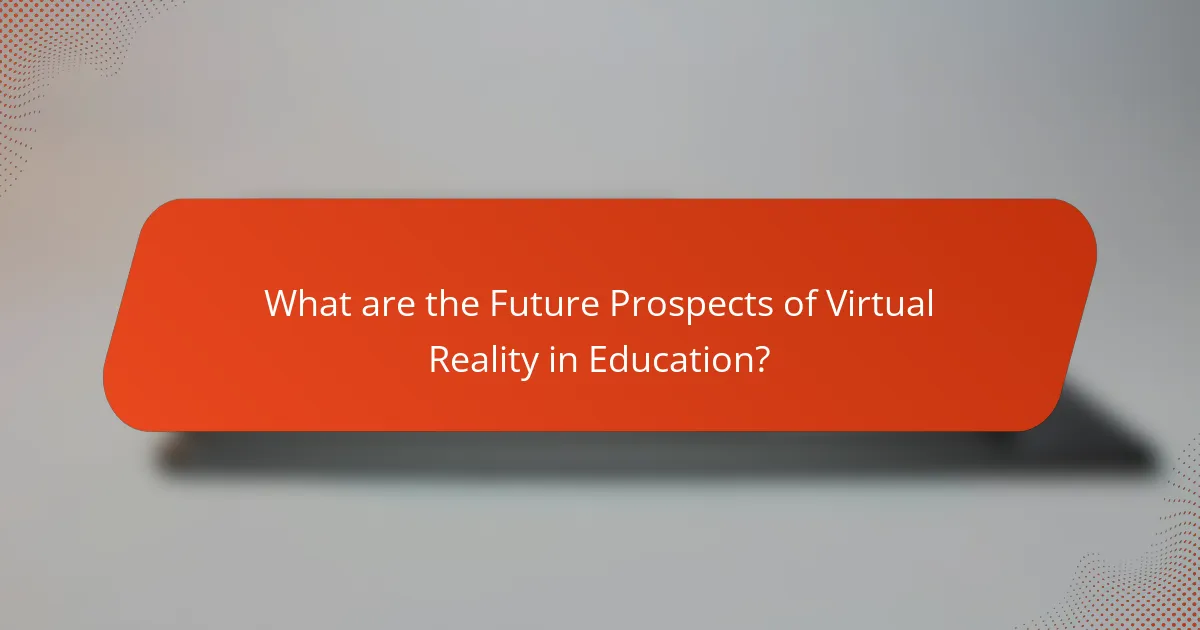
What are the Future Prospects of Virtual Reality in Education?
The future prospects of virtual reality in education are highly promising. Virtual reality technology will enhance immersive learning experiences. It allows students to engage with complex subjects in interactive environments. Research indicates that VR can improve retention rates and understanding of material. A study by the University of Maryland found that students using VR scored 20% higher on tests compared to traditional learning methods. Additionally, VR can facilitate remote learning, making education more accessible. As technology advances, costs are expected to decrease, further integrating VR into classrooms. Overall, virtual reality is set to revolutionize educational practices and outcomes.
How is the technology evolving to meet educational needs?
Technology is evolving to meet educational needs through advancements in virtual reality (VR). VR enables immersive learning experiences that enhance student engagement. This technology allows for interactive simulations that replicate real-world scenarios. According to a study by the University of Maryland, students using VR scored higher in retention and understanding. Furthermore, VR provides access to resources that may be otherwise unavailable. For instance, students can explore historical sites or complex scientific concepts virtually. The integration of VR in classrooms is increasing, with many institutions adopting these technologies. This evolution reflects a shift towards personalized and experiential learning methods.
What advancements in Virtual Reality can enhance learning experiences?
Advancements in Virtual Reality (VR) significantly enhance learning experiences. Immersive simulations allow learners to engage in realistic environments. These environments facilitate experiential learning, which improves retention. Interactive elements in VR promote active participation. This leads to deeper understanding of complex subjects. Adaptive learning technologies personalize experiences based on individual needs. Studies show that VR increases motivation and engagement in learners. For example, a 2020 study by Mikropoulos and Natsis found that VR-based learning improved student performance in science subjects.
How might future trends in Virtual Reality shape educational practices?
Future trends in Virtual Reality (VR) are likely to significantly enhance educational practices. VR can provide immersive learning experiences that engage students more effectively than traditional methods. For instance, students can explore historical sites or conduct virtual science experiments in a safe environment. Research shows that immersive VR experiences can improve retention rates by up to 75% compared to conventional learning techniques. Additionally, VR allows for personalized learning paths, catering to individual student needs and learning speeds. As technology advances, VR tools will become more accessible and affordable for educational institutions. This accessibility will encourage widespread adoption and innovative pedagogical approaches. Overall, future trends in VR will transform how educators deliver content and how students interact with learning material.
What best practices should educators follow when integrating Virtual Reality into their curriculum?
Educators should follow several best practices when integrating Virtual Reality into their curriculum. First, they must align VR experiences with learning objectives. This ensures that the technology serves educational purposes. Second, educators should provide adequate training for both instructors and students. Familiarity with VR tools enhances engagement and learning outcomes. Third, they should create immersive and interactive experiences. Studies show that active participation improves retention rates. Fourth, it is essential to assess the effectiveness of VR integration regularly. Continuous evaluation allows for adjustments to improve the learning experience. Lastly, educators should consider accessibility for all students. Providing alternative options ensures inclusivity in learning. These practices contribute to a successful integration of Virtual Reality in education.
How can educators effectively design Virtual Reality learning experiences?
Educators can effectively design Virtual Reality learning experiences by focusing on clear learning objectives. They should align VR content with curriculum standards. Engaging and interactive scenarios enhance student participation. Customization of experiences based on learner needs is essential. Incorporating feedback mechanisms helps assess understanding. Collaboration with VR developers can improve content quality. Research shows that immersive environments increase retention rates. A study by Mikropoulos and Natsis (2011) found that VR enhances spatial understanding in learners.
What tips can help educators assess the impact of Virtual Reality on student learning?
Educators can assess the impact of Virtual Reality (VR) on student learning by implementing several strategies. First, they should establish clear learning objectives before using VR. This helps in measuring specific outcomes. Second, educators can utilize pre- and post-VR assessments to evaluate knowledge gains. Research shows that students often demonstrate improved understanding after VR experiences. Third, collecting qualitative feedback from students enhances insights into their experiences. Surveys and interviews can reveal how VR affects engagement and motivation. Fourth, educators can observe student interactions during VR sessions. This provides real-time data on collaboration and problem-solving skills. Finally, comparing VR learning outcomes with traditional methods can highlight effectiveness. Studies indicate that VR often leads to better retention of information.
Virtual Reality (VR) in education is an immersive technology that enhances learning through simulated environments and interactive experiences. This article explores the definition, key features, and benefits of VR in educational settings, highlighting its impact on student engagement, retention, and skill development. It also addresses the challenges associated with implementing VR in classrooms, such as costs and the need for trained educators. Additionally, the article examines future prospects and best practices for integrating VR into curricula to maximize learning outcomes.
